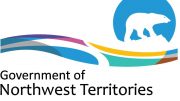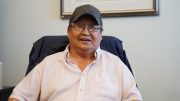Lesa Semmler says she feels like the territorial government is trying to reinvent the wheel when it comes to administering the COVID-19 vaccine.
The Inuvik-Twin Lakes MLA says the GNWT should do more to leverage local healthcare workers in the regional centres to get the vaccine to communities.
The COVID-19 vaccines are known to have specific requirements to maintain effectiveness — especially around the temperatures at which it is kept. The Moderna vaccine has to be kept between -15°C and -25°C.

Sean Marshall, lead logistician for the Northwest Territories Health and Social Services Authority, demonstrates one of the five freezer boxes in which mobile teams will transport the COVID-19 vaccine. (Francis Tessier-Burns/CKLB)
On Friday, health officials held a demonstration session showing the equipment and explaining the technicalities in how the vaccine will reach residents throughout the NWT.
Beyond the temperature, they said the vaccine is also more fragile compared to other common vaccines like the one for the flu.
Too much movement can destroy its structure rendering it ineffective. That’s why the territorial government says it is using mobile teams to deliver the vaccine. They will also be tracking all movements and temperatures as they travel to communities.
Equipment has been another challenge to contend with: there is a country-wide shortage of refrigeration equipment. The NWT has five freezer boxes to transport vaccines for longer travel. Once thawed the vaccine has a shelf life of 12 hours, and six hours once the vial is punctured.
“We want to be very careful when we remove a dose that we’re ensuring that we get the appropriate amount, and that we’re not having any wastage,” says Dawn DeBlieck, the clinical nurse educator. “That was a big concern for us.”
And in the case there is any wastage, teams are travelling with extra doses with the goal to vaccinate 75 per cent of the eligible population.
Local staff as ‘face’ of vaccine delivery
While Semmler says she understands the realities of backordered equipment and other logistical challenges, that doesn’t mean the department could not have had a communication strategy sooner.
“We’ve known we were getting the Moderna vaccine,” she says. “The frontline nurses, part of their job… Is to get out there and do health promotion. If we really wanted good uptake, you’d have local staff out there doing the education where they’re trusted by their community.”
Semmler is speaking from personal experience — she spent 12 years as a public health nurse in Inuvik, including during the H1N1 pandemic.
“Sometimes I feel like when we’re under stress, we we cause more barriers for ourselves,” she says.
Scott Robertson is a nurse and COVID operations co-lead for the NTHSSA; he also helped plan the rollout of the H1N1 vaccine, which he says was simpler than the COVID one.
“We have ongoing messaging and information that we’re providing to communities,” he says. “We are asking our local health staff, our nurses and community health workers, to provide opportunities to speak on the local radio to provide information.
Robertson says that he and the wider COVID operations team realize that “trust is critical in any healthcare relationship” and want “local health workers as the front face of this.”
He added that the mobile teams to include local healthcare workers while they were in communities.
While Inuvik has received its first doses for long-term care residents and staff, Semmler says public health nurses have been telling her they have not been engaged to share the vaccine rollout plan.
“It seems like we’re waiting for somebody to push a button in Yellowknife to say, ‘Okay, now you can do this’,” says Semmler.
Who are these mobile teams?
At minimum, Robertson says the teams will be made up of a minimum of four people — two nurses and two logisticians — but the actual size will depend on the size of the community and resources already available.
He says northern nurses are being reassigned to the vaccination teams where possible. Others are coming in from the south; any workers that will be part of the mobile teams are self-isolating for two weeks before going to communities.
Jackie Jacobson, MLA for Nunakput, says overall he’s satisfied with the government’s vaccine plan. Next week, teams are scheduled to visit three of the four communities Jacobson represents (among others) and the vaccine will be available to all eligible adults over 18 years old.
“The teams come in and boom, it’s done,” Jacobson says. “And you’re not taking away from other parts of the community (healthcare).”
Both Semmler and Jacobson said they will be getting the vaccine and are encouraging all eligible northerners to do so when it is available for them.










